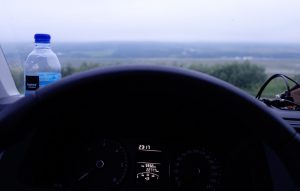Sandra wakes up around 6 and can’t go to sleep again so she reads the roadbook and surfs the web to check on the upcoming days. Outside it’s grey and wet as we’re sitting in a thick bank of low lying clouds. Skye wakes up too and works on correcting, illustrating and posting our second day blog post. Ryo who usually sleeps very little is not the least bit bothered by the constant light and sleeps like a log: that fresh Icelandic air I suppose.
It is nearly 10 when we are finally packed and ready to live our cosy cottage. We enjoy a big breakfast served at a nearby hotel and head to the Glaumbaer folk museum, the first stop of the day on our tour of the Trollaskagy peninsula. Glaumbaer is on the circle road (the road that circumnavigates all of Iceland) so it’s fairly busy when we arrive, and the site is crawling with a coach of Italian tourists. It’s a very interesting and pretty museum showing how the first settlers lived in a farm made out of turf. The living quarters, kitchen, dairy and storage rooms are organized around a narrow corridor partly dug in the ground and surrounded by mud-walls and covered with turf. It really looks like a cross of a Hobbit house of those of Rohan in Lord of the Ring!
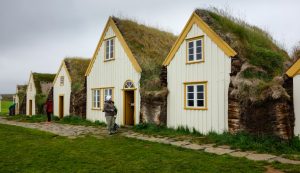
Back in the day over 20 people shared these cramped quarters: the farmer, his family and the workers. People passed their spare time and ate directly on their small bed that they apparently shared in pairs. The exhibition is excellent and each room is full of lots of artifacts of everyday life. Due to lack of commerce in these remote regions, many of the objects were made by the farmers locally. A smithy let the inhabitants build their own iron tools, much of the furniture was fashioned from driftwood (as there were not many trees for timber in the area), and even a mold for shaping cattle horns into spoons. Some ice skates made with cow and horse bones are also intriguing as well as very pretty iron-and-driftwood skates and metal cow shoes with spikes for leading cattle across the ice.
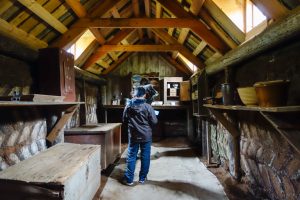
Our next stops are birdwatching spots along the coast that Skye found on a birding map he bought at the last hotel. We first drive to a small lake were we see gazillions of noisy and indignant but pretty limosa limosa (their Latin name much more fun to say than Black-tailed Godwit). As our tire warning has come on again, Skye stops at a petrol station and adjusts the pressure in the tires. Everything seems OK, and since we no longer have the Jones on board, he even lowers the pressure a bit.
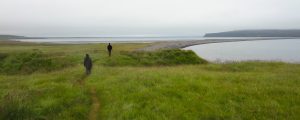
We carry driving through the clouds along a track that takes us to the coast and discover nesting Harlequin Ducks. They are an endemic bird (found only in Iceland) and the male is very pretty with colourful patterns. Our next stop is to a natural stone sandbar which has created a lagoon between the mainland and an island. We spot some Eiders, the ducks whose feathers are used to make warm eiderdowns (édredons in French). As we reach the northern point of the peninsula, we are treated to some sun poking through the cloud. The peninsula is becoming more and more dramatic with high mountains still covered in large patches of snow, and cliffs plunging in the ocean. Here and there the soil steams with geothermal sources and there are quite a lot of farms scattered in the area. We stop at a lookout point with a picnic table for some lunch: rice salad made from yesterday’s leftovers, and blueberry Skyr with fresh berries.
We continue on and go through a small one-way tunnel and arrive into a scenic fjord at the end of which stands Siglufjördur, a fishing town that made its fortune with its herring industry. Our roadbook as well as the Lonely Planet both say the herring museum is well worth a visit. It is indeed absolutely fascinating. The first building we visit is a house for “herring girls”: we discover in a black and white movie from the 50’s that during the herring years (early 1900s until the late 60s), thousands of women and children would flock into Siglufjördur to sort and cure the fish that arrived daily during the short two-month summer season. Sixty women lived in this house and the museum recreates the interiors with offices, sleeping rooms, bathroom, kitchen and other objects of everyday life from this period.
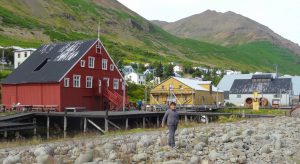
The next building we visit houses an entire fishing boat and the smaller auxiliary boats used to round up the fish alongside the main vessel. The exhibition is really well done: it’s like being in the harbour at night and walking along the docks: you can step onboard the boats, and climb down into the mess or into the hold where the fish were stored. They have done an incredible job with all the objects collected and curated that bring the scene into life. Only the smell of herring is missing!
The last building of the exhibition is a reconstruction of a transformation plant where part of the catch was separated into oil for the industry and fish meal to feed cattle. There are gigantic steam-powered generators from the early 20th century, including the “Atlas” made in the USA by General Electric.
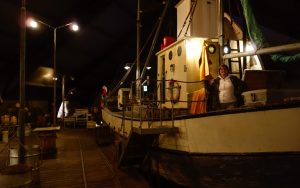
We’ve really enjoyed this fascinating visit that gives us yet another aspect of the history of Iceland and are ready to continue our trip back down the other side of the peninsula towards Akureyri. Just a few years ago we would have had to retrace our steps and drive by the ring road. But now they’ve bored an 11 km tunnel through the mountain, linking Siglufjördur with Olafjördur. We pay particular attention to the tunnel walls as Sandra’s uncle spent several weeks in this remote region injecting resin to seal cracks in the tunnel… he was called in as a consultant because the Swiss are at the forefront of tunnel technology. He told us it was an interesting job but really dragged on because there was very little to do in his spare time, which (having seen the one-horse towns on either side of the tunnel) we can understand!
We have go through another one-way tunnel that is 3km long (cars coming the other way have to duck into little cubbyhole lay-bys and wait for us to pass) before reaching Eyjafjördur. We can still see a bit of the beautiful snow dappled mountains through the clouds that line this very scenic fjord. We reach Akureyri by 6 o’clock. It’s the second-largest city in Iceland with 18’000 inhabitants. Our guesthouse is perched on the other side of the river that flows down to the fjord. We cross over a maze of stone dykes and pass by the airport’s airstrip which is built on the water.
The guesthouse is a pretty yellow building that overlooks the marshes from high up the hill. We install ourselves in our small room and relax with an apéro. It’s about eight when we drive back down to the centre of town with the aim to eat a fusion fish dinner at the renowned Rub 23. But it’s full until 9:30, so after a short walk along the main street we head back to our car to try our luck at Noa, another fish restaurant a bit out of town. Here too there is an hour wait, but Sandra spots a walking trail up on the hill behind the restaurant and decides we could have an appetite-building walk up there, so we reserve a table for 9:45 and set off for a walk. We discover a tourist sign explaining that we are in fact in the old town of Akureyri and that there are a lot of old houses along the road and a nice historic walk to follow.
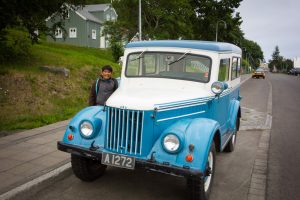
We enjoy discovering the colourful buildings and their pretty gardens: the residents take good care of their flowers, trees and lawns in the short months when they can enjoy them! The path then takes us up the slope to a small forest, and once on top we walk through the local cemetery where Ryo spots (oddly) an oystercatcher, an odd bird to find so far from the sea!
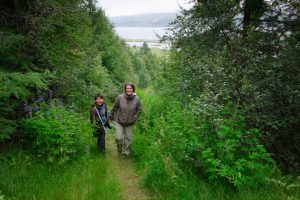
On the way back down, we pay a visit to the “Nonni” stone. It is well-known because mentioned in a children’s novel written by a local author. In the early 1900s his father died, and his mother, unable to provide for the entire family had him sent to boarding school in France, via Copenhagen. He wrote a book about his experience which became a popular series of children’s books: the “Nonni books”. We finish our nice walk just in time to claim our table at Noa and we enjoy a fabulous fish meal, a view over the fjord, and the nice ambiance of the restaurant.
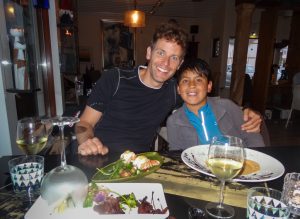
For starters we share an excellent lobster soup, delicious local cured meats and cheeses, and a lobster salad with lemon vinaigrette. Yummy! We then order the catch of the day for Skye: wolf fish in a creamy dill sauce, bacalau for Sandra, and cod for Ryo. The restaurant serves the mains directly in cast iron frying pans: the pan-seared fish is tossed with baby potatoes, pearl onions, spinach leaves and topped with cherry tomatoes, Icelandic cucumber, and on Sandra’s bacalau also olives and sundried tomatoes.
We are very full when we return to our guesthouse, and also very tired. It is almost midnight and still daylight… amazing!
